Common menu bar links
Breadcrumb Trail
ARCHIVED - Canadian International Development Agency
 This page has been archived.
This page has been archived.
Archived Content
Information identified as archived on the Web is for reference, research or recordkeeping purposes. It has not been altered or updated after the date of archiving. Web pages that are archived on the Web are not subject to the Government of Canada Web Standards. As per the Communications Policy of the Government of Canada, you can request alternate formats on the "Contact Us" page.
Minister's Message
 As the new Minister for International Cooperation, I am pleased to present the report on the achievements of the Canadian International Development Agency during 2006-2007. The Agency's performance reflects the ongoing commitment of the Government of
Canada to development cooperation, not only in the context of doubling of the aid budget between 2001-2002 and 2010-2011, but also in terms of increasing the effectiveness of Canada's aid. The Agency has drawn from country reports, sectoral reports and other sources in a continuing effort to demonstrate results for Canadians and concrete progress in strengthening CIDA's accountability
regime.
As the new Minister for International Cooperation, I am pleased to present the report on the achievements of the Canadian International Development Agency during 2006-2007. The Agency's performance reflects the ongoing commitment of the Government of
Canada to development cooperation, not only in the context of doubling of the aid budget between 2001-2002 and 2010-2011, but also in terms of increasing the effectiveness of Canada's aid. The Agency has drawn from country reports, sectoral reports and other sources in a continuing effort to demonstrate results for Canadians and concrete progress in strengthening CIDA's accountability
regime.
CIDA placed greater emphasis on two critical areas in 2006-2007 - democratic governance and equality between women and men. The Agency established its Office for Democratic Governance to mobilize Canadian expertise in this sector, and made considerable headway in a number of key areas.
CIDA is also responding to new government priorities such as the renewed attention to the Americas.
CIDA is continuing to make progress in the implementation of its aid effectiveness agenda. Our government's commitment to ensuring accountability for results was reiterated in Budget 2007. There is greater geographic and sectoral focus, more efficiency in programming and clearer demonstration of concrete results to Canadians. The Agency is moving toward a stronger field presence, and is managing human resources to meet the requirements of the future.
This document is a record of achievement, set against a background of continuing challenges, tremendous change and global uncertainty. I respectfully table it for Parliament's consideration.
The Honourable Beverley J. Oda, P.C., M.P.
Minister of International Cooperation
Management Representation Statement
|
I submit for tabling in Parliament, the 2006-2007 Departmental Performance Report for the Canadian International Development Agency. This document has been prepared based on the reporting principles contained in the Guide for the Preparation of Part III of the 2006-2007 Estimates: Reports on Plans and Priorities and Departmental Performance Reports:
Robert Greenhill |
SECTION I: AGENCY OVERVIEW AND PERFORMANCE
1.1 Summary Information
The Canadian International Development Agency (CIDA) is the principal federal department responsible for development and humanitarian assistance policy and programming. Since its establishment in 1968, CIDA has built an international reputation for innovation and leadership in key fields, such as: promotion of equality between women and men, substantial participation of civil society in the aid program; early implementation of aid effectiveness principles; engagement in fragile states; application of results-based management; and humanitarian assistance system reform.
Working with partners in Canada and abroad, CIDA manages, along with the Departments of Foreign Affairs and International Trade (DFAIT) and Finance, the International Assistance Envelope (IAE)1 , an envelope of approximately $4 billion.
Approximately 73 per cent of the IAE, or close to $3 billion, constituted CIDA's annual budget in 2006-2007. The Agency manages a similar budget in 2007-2008.
Together, CIDA, Finance and DFAIT ensure that envelope resources are spent in line with the government priorities. More specifically, this Government has committed to Canadians that aid would be more effective and deliver concrete, measurable results. As stated in CIDA's 2006-2007 and 2007-2008 Reports on Plans and Priorities (RPPs), this commitment is at the heart of the Agency's agenda and guides its actions.
Furthermore, in Budget 2007, the Government of Canada not only reiterated its commitment to doubling aid from 2001-2002 to 2010-2011; it also provided additional resources reflecting its current priorities, such as: $200 million for reconstruction and development in Afghanistan ($150 million through CIDA and $50 million through DFAIT)2 and $115 million initially and up to $230 million over time to the innovative Advance Market Commitment to create a pneumococcal vaccine.
|
A cross-section of selected development results, 2006-2007
|
This report reflects early actions with respect to the commitments made by the Government in Budget 2007 with regard to increased focus, efficiency and accountability. It contains several new elements to illustrate the wide range of results achieved during the year. In addition to the summary chart of results related to the Agency's program and management priorities, it provides a series of "reports " on development results in CIDA's sectors of focus. Furthermore, in line with Budget 2007's commitment to greater accountability, through reports on effectiveness in selected countries, we have included country reports based on annual programming performance reviews and on summaries of evaluations and audits. These provide an objective assessment of a representative cross-section of our programming.
SUMMARY CHART FOR 2006-2007
Rationale
Strategic Outcome: Sustainable development to reduce poverty in the poorest countries, measured through progress on the development goals3 of economic well-being, social development, environmental sustainability and governance (including freedom and democracy, human rights, rule of law, and accountable public institutions).
Alignment to Government of Canada Outcomes: Directly supports Government of Canada's strategic outcome of global poverty reduction through sustainable development and contributes indirectly to other outcomes, including a more secure world through international cooperation, and to a prosperous Canada through global commerce.
Benefits to Canadians: The aid program plays an important role in Canada's global reach and influence; provides a concrete expression of values that Canadians cherish; builds long-term relationships with some of the fastest-growing economies in the world; and helps make the world more secure for Canadians.
| Financial Resources | ||
| Planned Spending | Total Authorities | Actual Spending |
| $3,043,321,000 | $3,198,338,974 | $3,043,261,641 |
| Human Resources | |
| Planned | Actual |
| 1,578 | 1,671 |
| Departmental Priorities | Type |
| Strategic Focus | Ongoing |
| Strengthened Program Delivery | Ongoing |
| Effective Use of Agency Resources | Ongoing |
| Clear Accountability for Results | Ongoing |
| Program Activities | Planned Spending | Actual Expenditures |
| Geographic Programs | $1,637,749,000 | $1,588,475,777 |
| Partnership Programs | $279,608,000 | $273,413,338 |
| Multilateral Programs | $1,045,710,000 | $1,084,080,278 |
| Policy Coherence | $65,346,000 | $64,035,753 |
| Engaging Canadians | $14,908,000 | $33,256,4954 |
CIDA Aid Disbursements in 2006-2007
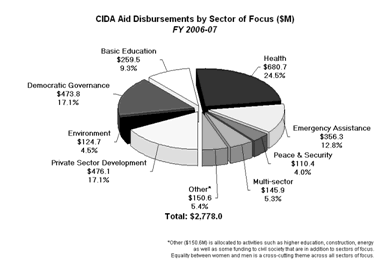
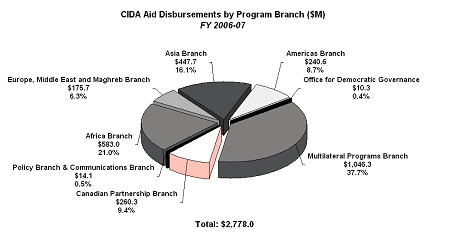
1.2 Departmental Performance
1.2.1 Context
Since 2000, the Millennium Development Goals (MDGs) have served to guide the development community's actions, including Canada's, toward a set of global targets, to be reached by 2015, for poverty and hunger eradication, health, education, gender equality, environmental sustainability, and global partnership.
Developing countries, often with the support of donors like Canada, have made concrete progress against these challenges in the last generation: life expectancy has increased by nine years, despite the ravages of HIV/AIDS; the number of people living on less than $1 per day has fallen from one person in three in 1990 to one person in five in 20045 thanks in part to rapid economic growth in Southeast Asia, China and India; access to water has improved; access to basic education has increased dramatically, especially for girls in Africa; and democratic governance is strengthening in all regions of the world.
Each region of the developing world faces unique challenges and opportunities. In Sub-Saharan Africa, recent economic growth and advances in democratic governance have opened the door for long-term, sustainable development. Despite this progress, the continent still faces major challenges in public health, basic education, equality between women and men, depletion of natural resources and ongoing conflict in many areas. In Asia, economic reforms and sound economic management have strengthened growth, and most countries in the southeast will achieve the MDGs. Despite gains, important challenges remain in Southern Asia, which, in absolute numbers, continues to account for an overwhelming proportion of the world's poor and is projected to continue to do so beyond 2015. The increasing gap between rich and poor, combined with unrest related to social, gender, ethnic and religious issues, continues to affect regional stability.
In the Americas, recent progress in poverty reduction, education and health have put most countries on track to meet the MDG targets, despite persisting inequalities in income and standard of living. However, growing security problems, including crime and violence, threaten to destabilize the region, particularly in Central America. In Eastern Europe, the Middle East and the Maghreb, the benefits of recent economic growth have not always been evenly distributed, and unstable security situations continue to be a challenge in certain areas. Progress is being made in these regions to strengthen institutions, enhance education and improve the local business environment.
1.2.2 CIDA's Environment
Strengthening Aid Effectiveness
Over the past ten years, there has been an increasing body of research into how to improve the effectiveness of aid in terms of delivery and accountability for results, and a growing international consensus on the ways and means to do so.
In 2005, the international development community endorsed the Paris Declaration on Aid Effectiveness, a principles-based approach to maximize the impact of aid on development outcomes.
|
Lessons Learned for Aid Effectiveness Countries succeed when there is...
Donors succeed when they...
Aid works when countries and donors...
|
There is a high level of interest in Canada to improve aid effectiveness actions. In Budget 2007, the Government reiterated the need to improve the effectiveness of Canadian aid and ensure accountability for results by presenting a three-point program aimed at:
-
Strengthening focus: Canada will focus traditional bilateral aid in fewer countries and will aim to be among the largest five donors in core countries of interest;
-
Improving efficiency: Canada will establish a benchmark for reducing administrative costs and will put more staff in the field; and,
-
Increasing accountability: Canada will examine options to ensure the independent evaluation of our aid program and will report more frequently to Canadians.
This program reinforced commitments made by the Government in 2006, in both the Speech from the Throne and the Budget: to ensure greater accountability in the distribution and results of Canada's international assistance. It is within this context that CIDA developed its aid effectiveness agenda6 which includes: 1) a strategic focus of our programming where it can have the greatest impact, 2) strengthened program delivery, 3) effective use of the Agency's resources, and 4) a clear accountability for results.
CIDA's agenda is consistent with the three-point program announced in the Budget, and goes further by providing a framework for a sound choice of sectors or program delivery mechanisms. The Agency has been implementing this agenda over the past year. Some of the work accomplished includes: making democratic governance a mandatory sector of focus in all major country programs; setting up the Office for Democratic Governance (ODG); improving the performance management system; and developing a Canadian Leadership Plan to recognize the role of civil society in promoting aid effectiveness within the international development community.
CIDA's Operating Environment
CIDA's mandate is implemented through programs with countries, Canadian, multilateral, international partners and local partners. In 2006, Treasury Board (TB) approved a revised Program Activity Architecture (PAA) and strategic outcomes as the basis for CIDA's Management, Results, and Resources Structure (MRRS). This represents a significant step forward in the way that CIDA captures results. It was developed to articulate the Agency's contribution to developing countries' achievement of their development results and, ultimately, to poverty reduction. Relationships are fundamental to the nature of CIDA's accountability for development results, whether these relationships are with governments, multilateral and bilateral donors, or with civil society and the private sector in and outside Canada.
This new structure provides a strong framework for performance measurement and reporting and served as the basis for CIDA's 2007-2008 Estimates.
Figure 1: CIDA's Program Activity Architecture Cross-Walk
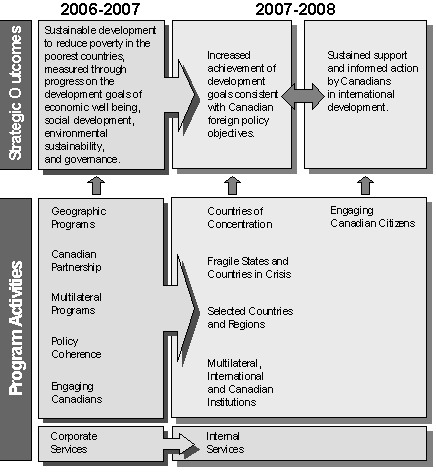
1.2.3 Key Commitments: Highlights of Achievements in 2006-2007
CIDA's 2006-2007 RPP presented 11 key deliverables in support of the Agency's overall priorities and commitments. Each deliverable supports CIDA priorities, i.e. progress toward the implementation of the four part aid effectiveness agenda. The table below provides CIDA's performance status for each of these key deliverables, as well as a list of selected activities and programming highlights to support the rating given to each of them.
CIDA's report card should remain understood as a valuable though subjective exercise, which reflects the results of a process of reflection and self-assessment internal to the Agency.
| Priority 1: Strategic Focus | |
| Key Deliverables | Performance Status and Highlights |
| Concentrating programming in priority sectors: A limited number of sectoral priorities, including democratic governance as a mandatory area of focus, will be identified in all major country programs. CIDA will integrate gender equality, including women's participation in decision-making, their human rights, and access to resources, in all sectors. |
Objectives Met - CIDA has made progress towards its objectives with regard to democratic governance and equality between women and men, as well as other sectors of focus. Examples of highlights in support of this assessment include:
|
| Concentrating on fewer countries: A financial strategy is being developed to increase bilateral resources in core countries of concentration. |
Objectives Partially Met - The phasing-out of some countries and the increased concentration in countries where CIDA can make a difference show continued progress in CIDA's efforts toward greater concentration.
|
| Priority 2: Strengthened Program Delivery | |
| Key Deliverables | Performance Status and Highlights |
| Reviewing and renewing partnership programming: CIDA will complete the development of policies and principles for its future work with Canadian partner organizations. The process will include ongoing dialogue with Canadian stakeholders and specific attention to effective linkages with southern non-governmental organizations (NGOs). |
Objectives Met - Much effort has been put towards the renewal of partnership programming. Next steps include the development of an action plan for renewal, as well as for the strengthening of civil society's contribution to development.
|
| Optimizing the multilateral channel: CIDA will focus its support on the most effective institutions showing concrete results on the ground. Over the next year, the Agency will work with other government departments and other donors to develop effective and relevant assessment criteria for these institutions. |
Objectives Partially Met - CIDA has made progress on the development of a framework to assess multilateral organizations' effectiveness and relevance, despite challenges, such as the number and diversity of multilateral organizations and discussions with other donors about the possibility of a harmonized approach.
|
| Integrating internationally agreed principles of aid effectiveness in all programming approaches: CIDA will develop a policy and operational framework to strengthen the development impact of Canada's aid program. |
Objectives Partially Met - While the DAC survey shows Canada is a good performer on the implementation of the Paris Declaration on Aid Effectiveness principles, ranking comparably to the European Commission, efforts are still needed to improve our performance and meet others, such as the United Kingdom, the Netherlands, and Sweden.
|
| Priority 3: Effective Use of Agency Resources | |
| Key Deliverables | Performance Status and Highlights |
| Managing change: Setting up to meet the challenge of effective development has a profound impact on all aspects of CIDA's operations. A Secretariat has been established to coordinate the Agency's transformation. |
Objectives Met
|
| A representative and sustainable workforce equipped with the core competencies and supportive business processes to deliver business imperatives, including field presence initiatives: Building on recent work, the Agency will focus on defining future key competencies and designing corporate recruitment strategies and learning programs to meet business needs. Business process impediments will be identified and resolved, while ensuring accountability, transparency, and appropriate risk management. |
Objectives Met
|
| A robust, well-governed human resource management (HRM) system aligned to CIDA's current and future business needs: In the short term, CIDA's goal is to strengthen HRM systemic integrity and business effectiveness, working in partnership with line management to ensure sound HRM decision-making that meets the business needs and protects the corporate interest of the Agency. In 2006-2007, efforts will be focused on establishing integrated HRM and business planning frameworks and instruments to assist the organization in identifying and meeting its current and future business requirements. |
Objectives Partially Met
|
| Working toward a coherent cross-government approach: CIDA is developing strategic framework arrangements with other key federal departments to leverage their expertise, initially in the area of governance, and enhance policy and programming coherence. Programming in the areas of justice reform will be piloted within the newly created Public Sector Governance Initiative. In consultation with other departments, efforts are also underway to develop a framework for CIDA's response to fragile states and countries experiencing humanitarian crises. CIDA, in collaboration with its partners, will build on its first year of experience with the renewed management framework for the IAE in order to enhance its effectiveness as a tool to support strategic decision-making. |
Objectives Met
|
| Priority 4: Clear Accountability for Results | |
| Key Deliverables | Performance Status and Highlights |
| Strengthening risk management in the Agency: CIDA will continue developing an integrated risk management framework. This will include a risk communication strategy to highlight due diligence and improve its partners' understanding of CIDA's high-risk operation environment. In addition, the Agency will implement a financial risk management strategy. |
Objectives Met
|
| Renewing CIDA's Performance Measurement Framework: The Agency will revise its PAA and MRRS to better reflect Canada's strategic direction and priorities. |
Objectives Partially Met - CIDA, like other departments and agencies, needs to move forward on the next steps with regard to MRRS implementation
|
Management Results
Through the Management Assessment Framework (MAF) assessment, based on a series of indicators and measures, the TB Portfolio assesses CIDA's management performance. The 2006 MAF assessment shows that CIDA's results are positive. The Agency rates highly in the quality and use of evaluations and, has demonstrated improvements or is performing well in the quality of program and policy analysis, effectiveness of financial management and control and, in the effectiveness of the internal audit function. This assessment also indicates opportunities for improvement, including ongoing efforts to clarify our strategic objectives, to continue to push for results-based management and to improve corporate risk management.
CIDA's International Recognition
CIDA's performance and contribution in different sectors received international recognition in the past year. In November 2006, Helen Keller International presented CIDA with its "International Development Award" for its global leadership in Vitamin A supplementation for child survival, as the funder of the vast majority of the world's supply of Vitamin A capsules.
"From the front lines of hunger, CIDA, the Government of Canada and the people of Canada are indeed helping make the world a better place. Canada is one of our leading partners in the world in ensuring that the children of Africa have at least one cup of food a day so they can study and learn and develop their lives. We want to thank the Government of Canada for being one of our most secure and creative partners on the front lines of hunger. Canada is one of our top three donors this year. We need you for all of the hungry we're reaching."
Josette Sheeran
Executive Director of the World Food Programme
July 31, 2007
In May 2007, the Micronutrient Initiative, an Ottawa-based not-for-profit organization dedicated to eliminating vitamin and mineral deficiencies worldwide, won a World Bank Development Marketplace award for its project in Nepalese villages to fortify flour with micronutrients. The project was supported by CIDA funding.
In February 2007, Canada's contribution to humanitarian demining operations was recognized by the Organization of American States (OAS): "Canada has been one of the most consistent and important donors in humanitarian demining operations in Latin America, " said William McDonough, Director of the OAS Office of Humanitarian Mine Action. According to McDonough, "As a result of Canada's humanitarian aid and the support of 15 other donor countries, Costa Rica, Honduras, Guatemala and Suriname have declared their territories free of the impact of mines and unexploded ordnance".
In July 2007, the Tanzania's Children's Book Project, a CIDA-supported project, was honoured with the UNESCO King Sejong Literacy Prize for the efforts in the production of Kiswahili children's books and the training of teachers, writers, publishers and illustrators. For the third time, CODE, a Canadian international education and literacy development organization, and its African partners, were chosen as recipients of a prestigious UNESCO Literacy Prize for effective contributions to the fight to expand literacy in the developing world.
Canada's role in Afghanistan has often been recognized within and outside the country. Last May, for example, Seema Patel, Lead Project Consultant of the Post-Conflict Construction Project, Centre for Strategic and International Studies, stated before a Parliamentary Committee: "Canada has played a leadership role in the country [Afghanistan], one that I would like to see more NATO countries emulate. The security and development strategy and programs is in line with what works best in Afghanistan. Canada is leading by example, spending its reconstruction and development funds on projects that build loyalty and trust - that are led by local people, with outsiders playing a supportive and catalytic role." Canadian leadership in Afghanistan is presented in more details in the pages that follow.
Canadian Leadership in Afghanistan
The goal of CIDA's Afghanistan program is to support the efforts of the Government of Afghanistan, the Afghan people and the international community in stabilizing Afghanistan. The Afghanistan Compact guides Canada's efforts in Afghanistan to consolidate the government's authority and legitimacy across the nation and improve the Afghan people's well being.
Canada has committed $1.2 billion for the period 2001-2002 to 2010-2011 in development assistance through CIDA. This makes Afghanistan the largest ever recipient of Canadian bilateral development aid. It also places Canada among the lead bilateral donors to the country. Highlights from 2006-2007 include:
Microfinance Investment Support Facility for Afghanistan (MISFA) ($28 million in 2006-2007): MISFA is a national microfinance program that is now one of the largest in the world. The Government of Afghanistan launched the MISFA in 2003 as a multi-donor program aimed at building the microfinance sector in Afghanistan. Canada has provided strong support to this successful program since its inception, and it continues to be its lead donor. MISFA funds 13 local microfinance institutions that, in turn, provide small loans and financial services to poor Afghans-people who would normally be denied access to such services. CIDA has invested $56.35 million in MISFA, of which $28 million was disbursed in 2006-2007. CIDA's support has enabled MISFA to expand far beyond its own predictions.
National Solidarity Program (NSP) (more than $20 million in 2006-2007): The NSP is the Afghan Government's primary program for community development. By March 31, 2007, more than 16,500 community development councils (CDCs) had been elected and almost $280 million in grants had been distributed to CDCs in 279 districts, in all 34 provinces. More than 25,000 projects had been approved and some 11,000 had been completed. Under NSP, more than half of the community projects involve productive infrastructure such as irrigation, roads, and village electrification, thereby promoting productivity and stimulating local economies. A further quarter involves safe drinking water and sanitation, which assures better health for these communities.
Afghanistan Reconstruction Trust Fund (ARTF) ($18 million in 2006-2007): The ARTF supports the Government in its efforts to re-establish a fully functioning and representative government system. It reimburses a portion of the Afghan Government's day-to-day operating expenses, including expenditures for wages, benefits and other payments for government employees, as well as operations and maintenance of departments. CIDA's support to the ARTF ensures regular salary payment to more than 270,000 civil servants, including 144,000 teachers.
National Area Based Development Program (more than $9 million in 2006-2007, of which $6.1 million went specifically for Kandahar province): This project supports the Ministry of Rural Rehabilitation and Development 's poverty reduction programs at the district level by creating District Development Assemblies (DDAs), which assist in establishing District Development Plans. Besides enabling the poor to overcome extreme poverty and build sustainable livelihoods, these plans help to address the special needs of farmers dependent on poppy cultivation, disarmed militias, returning refugees and the rural vulnerable, including the nomadic Kuchi population. Since 2001, 137 DDAs have been formed; nine provinces have such assemblies operating in all of their districts (including Kandahar) and three provinces are partially covered. More than 540 recovery projects, such as dams, roads, bridges, and irrigation canals have been implemented, which benefits more than 2 million people. This is in addition to the number of quick impact projects that have provided homes for 4,000 families, as well as seeds and fertilizers to 70,000 farmers.
Mine Action National Development Budget ($7 million in 2006-2007): Of the total contribution, almost $4 million has been supporting a 12-month project in the Kandahar districts of Panjwayi and Zhari to demine 2.9 million square metres of contaminated land. Also, through this contribution, more than 8 million Afghans have benefited from mine risk education activities. In addition, under the Anti-personnel Mine and Ammunition Stockpile Destruction project, almost 29,000 tons of ammunition have been surveyed and more than 330,000 anti-personnel mines and 12,000 tons of ammunition have been destroyed as of January 2007.
Programs implemented through Canadian, multilateral and international partners funding are achieving the following:
- Strengthening the Rule of Law (more than $2 million in 2006-2007): Under a project implemented by the International Development and Law Organization, 75 prosecutors and 90 judges have been trained. Access to legal aid has also increased.
- Women's Rights Fund (close to $300,000 in 2006-2007): Women's rights to education, capacity building and participation in political processes are being reinforced with the support of the NGO Rights and Democracy.
- Salt Iodization ($750,000 in 2006-2007): The Micronutrient Initiative is preparing to provide iodized salt for up to 10 million Afghans, thereby helping to protect thousands of children from the risk of being born mentally impaired.
- Polio Immunization ($5 million in 2006-2007): As a component of the Global Polio Eradication Initiative, more than 7 million children are being immunized against polio, including more than 350,000 children in Kandahar Province.
- Food aid (nearly $12 million in 2006-2007): CIDA's contributions are assisting the WFP's efforts to reach more than 3.4 million people with food aid.
Enhancing Aid Effectiveness in Afghanistan - Results of a Review
CIDA recently completed a program review of the Afghanistan Program covering the period May 2005 to January 2007. The objectives of the Review were to assess performance in terms of progress made towards the achievement of the stated results and to ensure that the funds were properly managed.
In spite of the obvious constraints associated with the Afghanistan Program, the Review found that an appropriate accountability and risk management regime is in place to ensure that funds are properly used. The Program made good choices in terms of the types of initiatives funded and mechanisms used. Among the eight largest projects, which accounted for $178 million, or 63 per cent of the $285 million disbursed by CIDA during the period covered by the Review, six have significantly improved people's lives. One was under-performing and the funds were reallocated to well performing initiatives. Another was slow getting off the ground and was just starting. Among the remaining 19 smaller projects, some have had good results while others have had mixed results. Among the latter, were two initiatives that involved less experienced partners.
The Review also offers recommendations for improvements in strengthening monitoring/oversight as well as Program operations in the field through increased staff level and a fully operational Program Support Unit. The review identified a number of lessons and recommended improvement in three areas: strengthening monitoring and oversight; improving results tracking and reporting; and strengthening Afghanistan program activities in the field. CIDA is already implementing the recommendations.
1.2.4 Factors Affecting Performance in 2006-2007
Overall, the Agency has succeeded in making much progress with regard to the commitments set out in its 2006-2007 RPP. These successes have been achieved despite a number of challenges that may have affected performance, but that also provided valuable lessons.
CIDA works in some of the world's riskiest environments, exacerbated by extreme poverty, war and conflict, differential treatment based on gender, environmental degradation, social and economic instability, famine, infectious disease and natural disasters. In 2006-2007, conflict and security issues, political instability and an aging workforce were some of the most important factors affecting performance.
Security implications have an impact on CIDA's ability to implement projects as planned and contribute to delays. Delivering development assistance in areas of conflict and limited security (such as Kandahar Province in Afghanistan) poses significant safety challenges for development programs and staff security. Risks, however, are mitigated by limiting field presence of staff and by working closely with government and NGO partners. In such circumstances, CIDA chooses partners carefully by ensuring they have a solid reputation for results and performance in similar environments. Where possible, regular formal and informal monitoring and reviews are undertaken by both local CIDA staff and hired contractors. CIDA also uses information collected via monitoring activities undertaken by other government and non-government partners and donors. This mitigates potential risk to CIDA's capacity to account for its investments.
Political instability can also affect CIDA performance. CIDA programming in West Bank and Gaza was restructured following the victory of Hamas in the January 2006 Palestinian legislative elections and the suspension of Canadian assistance to the Palestinian Authority. Canada suspended, terminated or restructured projects that worked directly with the Palestinian Authority. Canada maintained the level of assistance to Palestinians but refocused its support to address humanitarian needs. Support was delivered primarily through multilateral institutions and other partners.
One of the Agency's internal emerging challenge is impending staff retirements. The anticipated gap in CIDA's workforce and loss of corporate knowledge is being addressed by efforts to integrate and plan capacity, and by capability strategies to ensure continued effectiveness, high performance and sustainability.
The following section, although not exhaustive, highlights a number of lessons drawn from CIDA's performance and experience in 2006-2007:
Partner capacity is the key to greater local ownership: CIDA encourages greater local ownership and accountability by using, wherever possible, the systems, procedures and developing country and regional institutions to implement, monitor and evaluate programs and projects. In the case of weak management and administrative capacity within a government, CIDA, in concert with other donors, sets realistic goals and provides training, technical assistance and mentoring in such areas as analysis, public financial management and procurement, and monitoring and evaluation of poverty reduction strategies.
Specialized tools and training for staff play key roles in advancing equality between women and men: CIDA has developed its technical capacity and that of its partners and continues to integrate lessons learned into new programs. For example, a gender review of all CIDA programming in Indonesia was conducted to take stock of lessons learned and inform future programming. The review noted that the tools and training program developed during a CIDA 2001 project have continued to serve as the basis for knowledge and action on gender mainstreaming. The review also stated CIDA has had considerable impact in raising awareness and knowledge of equality issues both in government and civil society.
The importance of critical mass within civil society: One of the key lessons drawn from CIDA's program in the Democratic Republic of the Congo is that it is much more effective to work with a coalition of organizations sharing the same goals and rallying around the same specific objective, such as ensuring a free and fair election process. The risk in these situations is that once the event has passed, fragmentation of civil society is often the result, which reduces the pressure on governments for accountability. To address this type of problem, CIDA, in collaboration with other donors, is supporting the strengthening of NGOs and the media in DRC, Ethiopia, Tanzania, Nigeria and Kenya to better enable them to demand accountability from their governments.
Leadership in innovations: Public and private partnerships can be very successful in using Canadian expertise, other countries, civil society and private sector organizations to assist developing countries. Canada will continue to pursue innovative approaches such as the partnerships with the Gates Foundation to fund research for a HIV/AIDS vaccine as well as the Advance Market Commitment (AMC) for pneumococcal vaccines. AMCs are designed to create stronger incentives for industry to develop and produce vaccines that meet the specific needs of developing countries. Both initiatives are consistent with Canada's agenda on aid effectiveness and results-vaccination has clearly been shown to be one of the most effective ways to fight infectious diseases.
1.3 Development Results in CIDA's Sectors of Focus
This new section illustrates selected development results in the following sectors: democratic governance, private sector development (PSD), health (including HIV/AIDS), basic education, environmental sustainability, and equality between women and men, these last two also being cross-cutting themes.
Democratic Governance
Context: Democratic governance is key to developing countries realizing the MDGs. Important progress has been made over the past 30 years with the collapse of some 60 dictatorships, particularly in Africa and Eastern Europe, and more than 81 countries making significant gains in democratization. However, challenges remain. Despite a downward trend in the number of armed conflicts in the world, there were still 25 in 2005. Women's participation in politics is still very low, with women holding less than 16 per cent of the world's parliamentary seats in 2005.
CIDA's approach: For democratic governance to be effective, it must be multidimensional, incorporating respect for human rights, equality between women and men, and the rule of law. It requires accountable and inclusive public institutions with the technical and organizational capacities to deliver a wide range of policies and services. And it requires a commitment to democracy, civic participation, independent media, and an active civil society that can provide checks on corruption and the abuse of power.
For CIDA, democratic governance consists of four mutually reinforcing elements: freedom and democracy; human rights; rule of law; and accountable public institutions, as well as a commitment to equality between women and men.
CIDA disbursements in 2006-2007: CIDA invested $473.8 million in democratic governance, or 17.1 per cent of total disbursements.
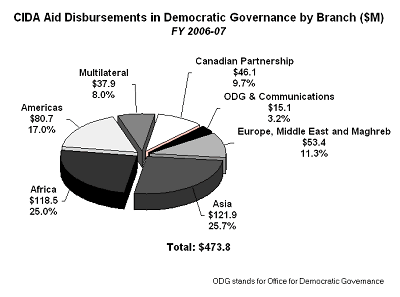
Selected Results in 2006-2007
-
With CIDA support, the Defensor del Pueblo in Bolivia, an NGO that works to ensure that the human rights of the poor and most marginalized people are promoted and protected, successfully remedied 3,000 human rights violations by 2006, trained 4,000 public servants to respect human rights and launched an anti-discrimination campaign on 129 different radio and television stations.
-
In its efforts to develop impartial and accessible legal systems that can deliver timely and effective justice, CIDA helped increase the capacity of Bangladesh's Ministry of Law to draft better laws and improve the country's prosecution, juvenile justice and legal aid systems.
-
CIDA helped the Government of Mali in implementing its tax reform, allowing it to surpass for the first time its customs revenue, thereby significantly increasing the country's overall revenue. This is a way to ensure accountable and transparent government that deliver essential public services to citizens.
-
CIDA helped Cambodia's parliamentarians to establish new practices for drafting legislation, consultations with stakeholders and the Cambodian public, encouraging informed debate within its Parliament, enhancing therefore freedom and democracy.
-
CIDA established the Office for Democratic Governance to consolidate the Agency's efforts in democratic governance and to leverage Canada's comparative advantage.
Health
Context: Every year, almost 11 million children under five die of preventable causes; HIV/AIDS claims three million lives; tuberculosis, two million, and malaria, 1.2 million; and 529,000 women die of causes related to childbirth. Health services suffer from quality, efficiency and equity gaps.
CIDA's approach: Programming focuses on policies, initiatives and relevant research that: prevent and control high-burden, poverty-linked diseases, particularly HIV/AIDS; improve infant and child health; improve sexual and reproductive health and reduce maternal morbidity and mortality; and improve food security and nutrition. CIDA has also scaled up its efforts to strengthen health systems and human resources for health.
CIDA disbursements in 2006-2007: CIDA disbursed $681 million in health, including HIV/AIDS).
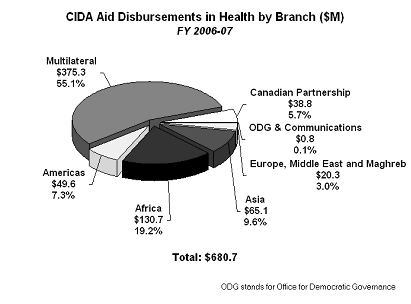
Selected Results in 2006-2007
-
As of December 2006, CIDA's support to the Global Fund to Fight AIDS, Tuberculosis and Malaria (GFATM) had contributed to providing antiretroviral treatment for HIV for 770,000 people (up from 384,000 the previous year), tuberculosis treatment to 2 million people (double the number of previous year) and 18 million insecticide-treated bednets to protect families from malaria (135 per cent more than previous year). As a result of these initiatives, approximately 1.8 million lives have been saved since 2002.
-
Insecticide-treated bednets have been shown to reduce child deaths from malaria by approximately 20 per cent. Beyond support to the GFATM, CIDA provided more than $43 million between 2003 and mid-2007 for the distribution of bednets in Africa, through partners such as UNICEF, the Canadian Red Cross and World Vision. This funding has enabled the distribution of over 4.5 million bednets, saving an estimated 128,000 children's lives.
-
In Mali, funding from the Gender and Development Fund in the Bandiagara circle led to the elimination of the practice of female genital mutilation in 68 villages, impacting the lives of approximately 47, 000 women and girls of reproductive age. The success of this funding also contributed to the development of a regional protocol to eliminate this practice.
-
Modern tuberculosis (TB) treatment not only cures TB in infected patients, it also curbs transmission of the disease, and the cost to save each person's life averages less than $200. The World Health Organization (WHO) indicates that CIDA's support in the fight against TB has saved approximately 750,000 lives in the last decade. Canada has been a global leader in TB treatment, playing an active role within the global Stop TB Partnership. CIDA was also the founding donor to the Global TB Drug Facility (GDF), which is managed by the WHO. Building on previous support to the GDF, CIDA's 2006-07 contribution of $25 million enabled the treatment of nearly 900,000 TB sufferers who would otherwise not have had access to the proper drugs, thereby saving an estimated 100,000 lives.
CIDA's Focus on HIV and AIDS
HIV/AIDS has been a program priority for CIDA for more than 10 years. On World AIDS Day, December 1, 2006, Canada launched its long-term, comprehensive approach to fighting HIV and AIDS globally. In 2006-2007, CIDA disbursed approximately $90 million for HIV and AIDS activities. Canada's overall response to HIV and AIDS is based on the principles of promoting gender equality; strengthening health systems to ensure equitable access to essential care, treatment and support for all those who need it; promoting the rights of children and protecting and supporting those children affected by HIV and AIDS; and ensuring an effective and evidence-based approach to prevention. CIDA recognizes the need to address the complex determinants of health in each community that increase vulnerability to HIV/AIDS and erode the resilience of women, men and children infected and affected by the epidemic.
A notable example of CIDA's focus on HIV and AIDS is CIDA's substantial support to the GFATM since its creation in 2002. The Global Fund provides large-scale financial support to expand country-led programs to improve vital health-care services. As of the end of 2006-07, Canada had contributed a total of nearly $530 million to the Global Fund.
Canada is committed to playing a leadership role in ensuring a comprehensive and integrated response to HIV and AIDS, particularly in developing countries and supports the scaling up efforts towards universal access to HIV prevention, treatment, care and support by 2010.
Canada was a key partner in hosting the International AIDS Conference in Toronto in August 2006. The Government of Canada also took a leadership role in hosting a Ministerial High Level Round Table discussion on the impact of HIV/AIDS on women and girls.
Among current initiatives CIDA is contributing to are:
-
Development of new prevention technologies. In February 2007, Canada announced the creation of the Canadian HIV Vaccine Initiative (CHVI), a collaborative effort between the Government of Canada and the Bill & Melinda Gates Foundation to contribute to global efforts to develop a safe, effective, affordable and globally accessible HIV vaccine. Canada is committing up to $111 million to the CHVI, and the Gates Foundation will provide up to $28 million.
-
Enhancing protection for children affected by HIV and AIDS. The Southern African AIDS Trust has helped to treat 340,000 children and 43,000 adults affected by HIV/AIDS and provided home care services to 42,000 people living with HIV/AIDS.
-
Promoting equality between women and men through prevention. In Zimbabwe, some 20,000 women have benefited from programs to prevent parent-to-child transmission of HIV/AIDS: 14,000 women took part in education and awareness workshops about transmission, 6,500 women received testing and counselling services and more than 800 women and 650 infants accessed anti-retroviral treatment.
Basic Education
Context: Developing countries have made important progress towards achieving the Education for All and MDG education goals over the last five years: primary school enrolment has increased, with spectacular advances in regions with the lowest enrolment, particularly in Sub-Saharan Africa; more girls are in school than ever before; since 2000, the number of out-of-school children has fallen by over 25 million; and both foreign and domestic spending for basic education has increased. However, challenges remain in terms of quality and quantity. Seventy-two million children are not in primary school. Children that are out of school or drop out are most likely to come from poor households and 57 per cent are girls.
CIDA's approach: CIDA has demonstrated sustained commitment to programming in basic education, especially girl's education, teacher training and capacity of national ministries of education. With other donors, CIDA invests in the implementation of national education plans, plays a leadership role in global partnerships and supports Canadian partners to increase access to marginalized groups and improve education quality.
CIDA disbursements in 2006-2007: CIDA disbursed $260 million on basic education in 2006-2007. Canada is on track to meeting its G8 commitment to increase funding for basic education in Africa from $100 million to $150 million annually by 2010-2011. Canada provided a one-time $25-million contribution to the Education for All Initiative (Fast Track Initiative and Global Monitoring Report). This funding is helping developing countries establish and implement sound national education plans.
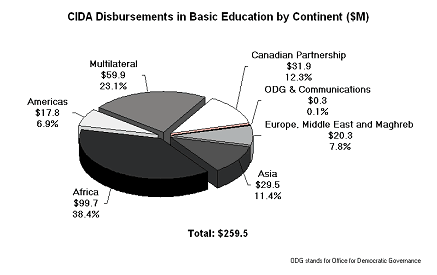
Selected Results in 2006-2007
-
Through its support to the Action Plan for Literacy in S�n�gal, CIDA helped to reduce the number of people who cannot read and write. In 2006, CIDA supported the creation of 2000 classrooms in 6 regions of the country, allowing over 62,000 people to have access to literacy training. CIDA's support to literacy in Senegal is mainly targeting women and youth.
-
Through Canadian support to the CODE/Progresso literacy program in Mozambique, close to 2,000 primary teachers increased their skills through in-service training; 56,000 copies of books were provided on HIV/AIDS in Portuguese; and 33 titles and over 100,000 copies of literacy books, manuals and booklets in five local languages were published and distributed. In 2005, Progresso was awarded the UNESCO International Reading Association Literacy Prize for their work in Mozambique.
-
As a result of CIDA-funded Save the Children Canada's basic education program, over 4,000 indigenous girls and boys in Bolivia and close to 3,000 indigenous girls and boys in Peru are completing quality formal education. Ninety-six children with disabilities have been mainstreamed into the formal education system.
-
CIDA's concentration of investments in basic education - more than doubling spending from 1999-2000 to 2006-2007 and increasing funding to Africa to $150 million annually by 2010-2011 - have contributed to at least 9 million additional enrolments at the primary level in Africa since 2000.
Environmental Sustainability
Context: Since 1990, the proportion of the world's land area covered by forests dropped by one per cent to 30 per cent; energy use per unit of gross domestic product (GDP) dropped but CO2 emissions nearly doubled; access to safe drinking water rose from 71 per cent to 80 per cent, but 1.1 billion people have no access to safe water and 2.6 billion lack sanitation services; nearly 1 billion people live in urban slums
CIDA's approach: In addition to systematically integrating environment in all its decision-making processes, the Agency focuses its efforts on climate change, land degradation, freshwater supply and sanitation, and addressing the environmental impacts of urbanization. CIDA regularly applies the Canadian Environmental Assessment Act (CEAA) and the Cabinet Directive for Strategic Environmental Assessment (SEA) of policy, plan and program proposals to integrate environmental sustainability linkages to its development interventions.
CIDA disbursements in 2006-2007: CIDA invested roughly $124.7 million in environmental initiatives, 63 per cent of which was disbursed through multilateral institutions, such as the Global Environment Facility (GEF). Due to a reduction in the amount of funds disbursed to GEF, CIDA's environment spending decreased by approximately 38 per cent from 2005-2006.
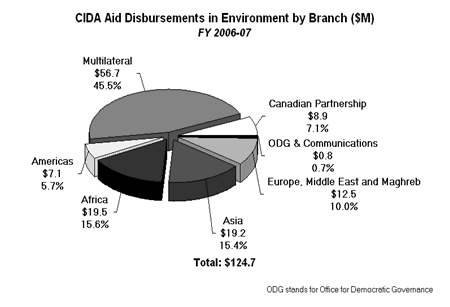
Selected Results 2006-2007
-
CIDA integrated environmental concerns into all new projects. Under the Cabinet Directive for SEA for 2004-2007, 116 Ministerial Decision Memos underwent SEAs representing programming investments of about $2 billion. Between the period of 2003-2006, 515 projects were assessed under the Act.
-
In Honduras, some 20,000 people in several rural communities have benefited from a clean water supply project, exceeding the target by 25 per cent. Initial comparisons with the baseline data reveal a significant drop in diarrhea and skin infections in the area as a result of the latrines, improved household wastewater drainage, and better health, hygiene and sanitation education.
-
In China, international-calibre expertise and policy advice to the State Council on environmental matters has influenced both policy and practice. Recommendations have guided development of regulations for the prevention and control of river basin water pollution and for cleaner production and recycling in industry.
-
In Peru, a new waste management facility processes some 25,000 tonnes of waste per week into recyclables and compost for community gardens.
-
CIDA is a long-standing supporter of the GEF, a multilateral organization that provides grants to developing countries for projects that benefit the global environment and promote sustainable local livelihoods. Through CIDA, Canada contributed approximately $35.5 million in core funding to the GEF in 2006. The GEF's 2005 performance study indicates that the GEF's programs have had a notable impact on reducing the loss of biodiversity, played an important role in promoting energy efficiency in developing countries, and helped to reduce the production, trade, and emissions of ozone-depleting substances.
Private Sector Development (PSD)
Context: Significant economic progress has been made in Eastern European and Asian countries, and improvements to the business-enabling environment have been observed in Africa and Latin America. In the developing world overall, 19.2 per cent live on less than US$1 a day, down from 31.6 per cent in 1990. However, the gap between rich and poor is widening; in 1990, the poorest fifth of the population in developing countries held 4.6 per cent of the national wealth; by 2004 that had dropped to 3.9 per cent.
CIDA's approach: CIDA supports developing countries' efforts to strengthen their private sectors in order to foster broad-based economic growth that contributes to poverty reduction and sustainable development. Programming focuses on promoting entrepreneurship, creating a business enabling environment, and strengthening connections to markets.
CIDA disbursements in 2006-2007: CIDA's private sector development investments amounted to $476.1 million, or 17 per cent of total CIDA aid spending, an increase of approximately $90 million over the previous year. Agriculture represented the single largest sector of investments for CIDA within PSD, with $183 million disbursed in 2006-2007.
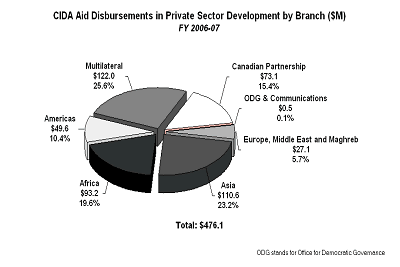
Selected Results in 2006-2007
-
In Indonesia, CIDA has been providing support, since 2005, to the Asia Foundation to create an environment in Sulawasi conducive to small and medium enterprise growth, by pioneering the creation of one-stop services centers in eight districts where business licenses and permits needed by business owners are issued in a more timely and efficient manner.
-
CIDA has committed $17 million to the development of the Hydrocarbon sector by supporting the Bolivian and Peruvian Governments to better enforce management practices and ensure that resources are exploited in a technically and environmentally sound manner. For example, CIDA's investments have been instrumental in providing Peru with capacity building to regulatory agencies in all technical aspects relating to the design, construction and operation of natural gas transmission and distribution pipelines.
-
With the objective of driving local development in Ukraine, CIDA has been supporting since 2002 the development of five very successful Rayon Business Centres, through the Small Business and Economic Development in Ivano-Frankivsk Regional Network Project. As a result of their services, more than 700 new businesses have been launched, over 12,000 jobs have been created and the community has seen increases in investment levels and tax revenues for local governments.
-
CIDA's support for the Consultative Group for International Agricultural Research - 15International Agricultural Research Centres - has contributed to progress on the MDG to eradicate extreme poverty and hunger. Through CIDA, Canada contributed approximately $17.4 million in core funding in 2006, enabling the group to contribute to results such as: increased wheat yields (while reducing production costs); rice varieties for Africa that have increased yields (while reducing labour by women farmers); and maize varieties with higher quality protein that have been planted on hundreds of thousands of hectares in 25 countries.
Equality between Women and Men9
Equality between women and men is a cross-cutting theme that is integrated across a significant portion of CIDA's programming.
Context: In addition to very high maternal mortality rates in Africa, women account for 75 per cent of young people living with HIV, and violence against women is often intensified in areas of conflict. In many developing countries, 60 per cent of women workers earn their living in the unprotected informal sector. In some parts of Africa, while women own less than 10 per cent of land, they perform almost 75 per cent of farm work. Women account for only 17 per cent of single and lower houses of parliament.
CIDA's approach: For over thirty years, Canada has been an international leader in promoting the rights and equality of women. Equality between women and men is a cross-cutting theme throughout CIDA's programming, which focuses on three critical results areas: equal participation of women and men in decision making; the human rights of women and girls; and women's equal access to and control over the resources and benefits of development.
In 2006, CIDA announced its intention to increase specific programming in equality between women and men to reflect the critical importance of enabling women's full potential for contributing to sustainable development, while maintaining integrated programming. Equality between women and men is one of Canada's two top development assistance priorities for enhanced focus in 2007-2008.
Selected Results in 2006-2007
-
In Malawi and Kenya, CIDA contributed to the realization of women and girls' human rights by supporting the development and passing of domestic legislation to address domestic violence. CIDA also contributed to strengthening their capacity to integrate gender equality considerations into their planning and implementation processes, including the development of budgets and medium-term development plans.
-
Through the Kore Fanm Fund, Canada has established itself as the only donor funding projects that support Haitian organizations and institutions that promote, protect and defend women's rights, and work to prevent violence against women. In 2006-2007, the Kore Fanm Fund achieved these results: awareness-raising of 17 political parties and the general political environment on the importance of women's participation; 1,500 women and 300 men were sensitized to gender equality; more than 1,600 members of 23 women's organizations in three departments received training and organizational support and centres for women victims of violence were set up in three departments.
-
CIDA-funded work in Bangladesh targeted, among other issues, employment of poor women. One such initiative, the very successful project Challenging the Frontier of Poverty, has increased the asset base of more than one million ultra-poor women, thus allowing them to increase their income, move up the finance ladder, thereby enabling them to access micro-credit services. An extension of this project has been approved to benefit even more recipients.
-
In Malawi, through the work of CARE Canada, awareness raising on HIV/AIDS in the schools has increased girls' assertiveness, and School Management Committees are now challenging the abuse of girls in the schools.
